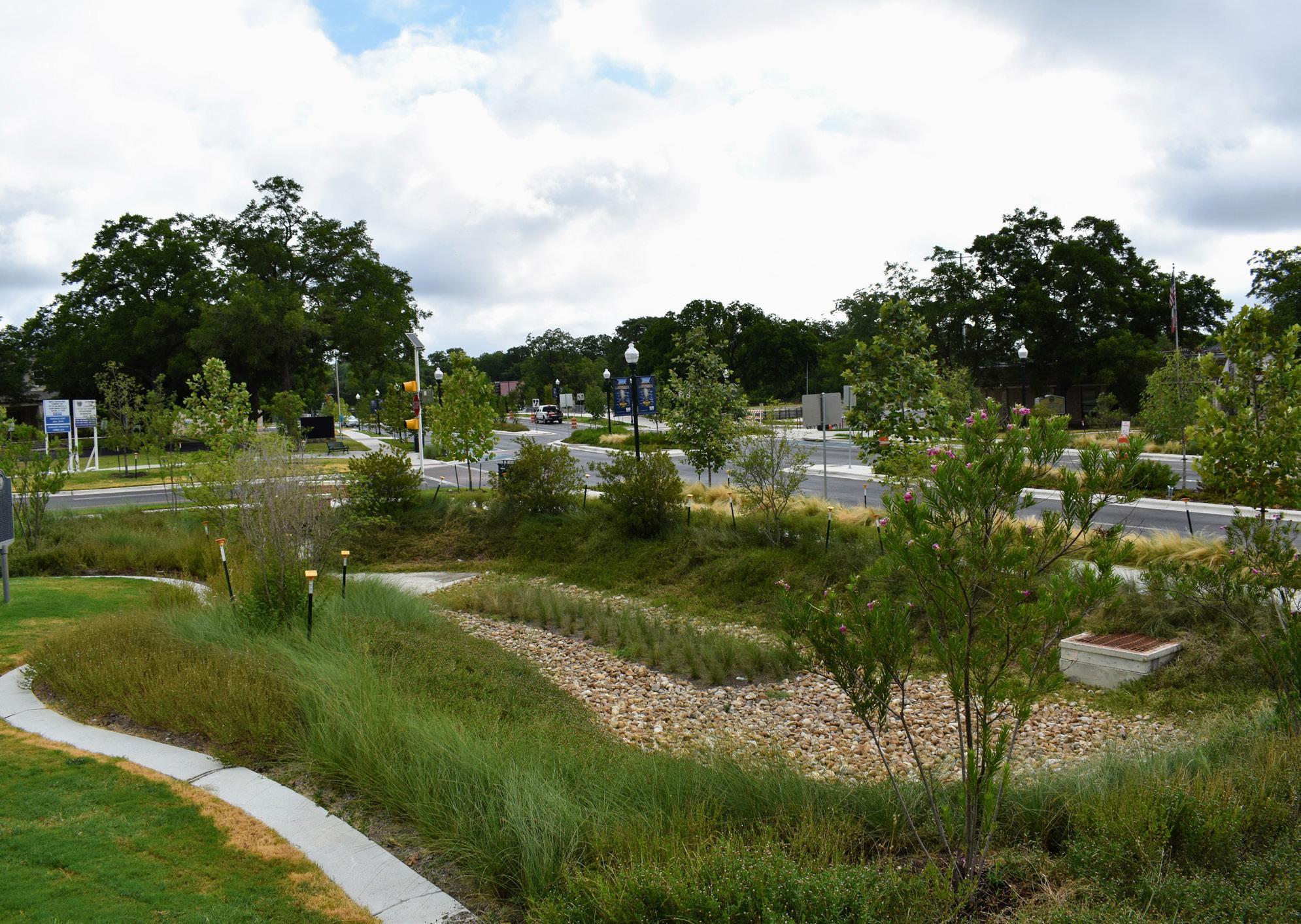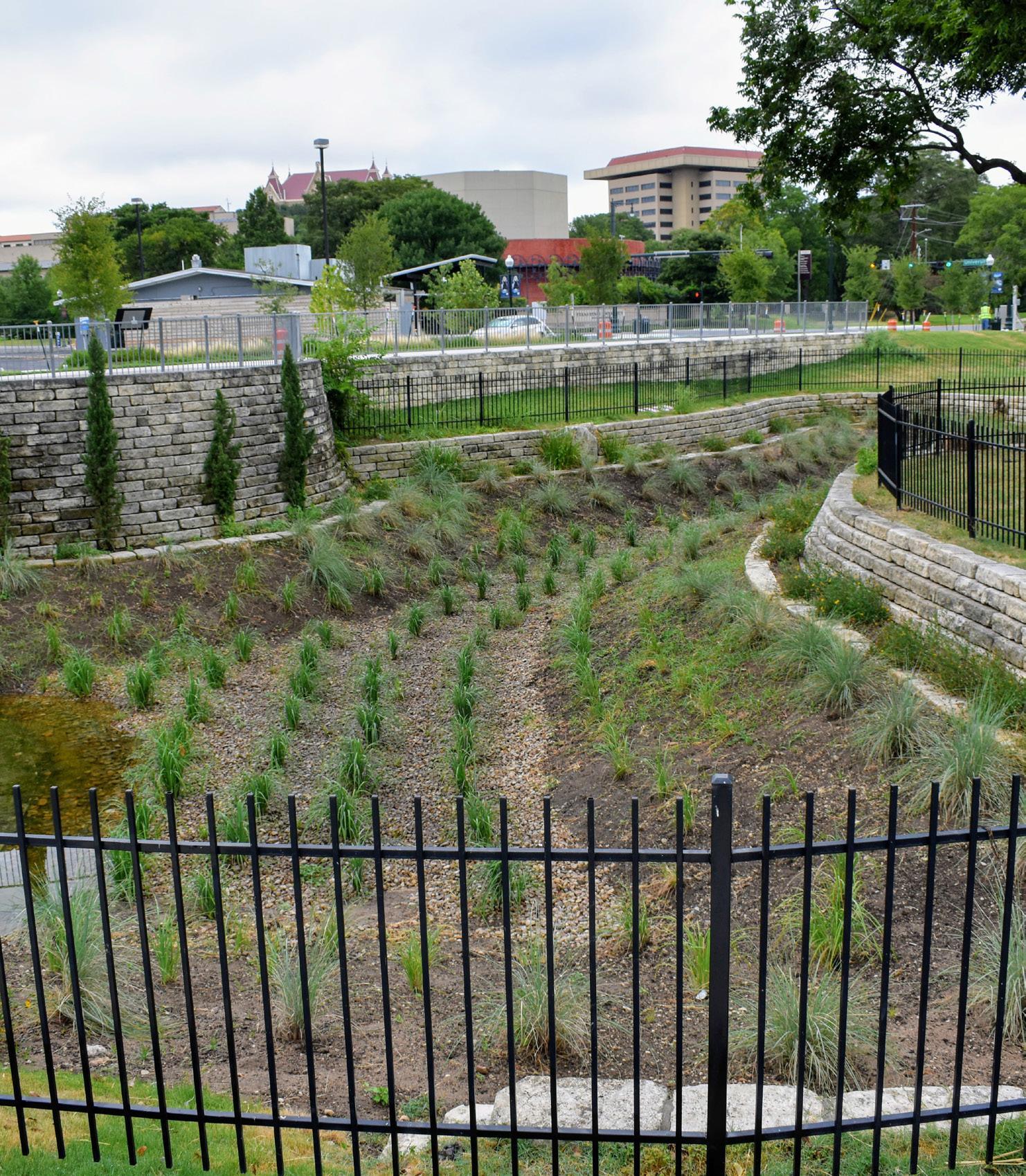
The Upper San Marcos River Watershed Protection Plan is in place to maintain clean water in this community. Pictured above and below are two views of the C. M. Allen Bioretention Basin.
Photos provided by San Marcos Habitat Conservation Plan Manager Mark Enders

Stakeholders work toward maintaining healthy watershed
Just as the city of San Marcos prepares to move into Stage 4 drought restrictions, amid a Monday that saw firefighters heavily engaged in battling wildfires across the region including off FM 1626, FM 2770 and Robert S. Light, which was closed from Smith Lane for part of the afternoon, a group of citizens have worked steadily behind the scenes to protect the Upper San Marcos River Watershed.
A watershed is an area of land that drains into a body of water whether that be a river, a stream, an ocean or an estuary. Pick any point on the map and water will drain into some water body, according to information provided during a recent Texas A&M Agrilife Extension Texas Watershed Steward Workshop.
This community resides in the Upper San Marcos River Watershed, one which is considered by experts to be pristinely clean, due to the combined efforts of community participants and other stakeholders.
“The San Marcos River— it’s fed by springs from the Edwards Aquifer,” San Marcos Habitat Conservation Plan Manager Mark Enders said, adding that the springs flow into the headwaters in the center of town.
Enders said citizens can contribute to a healthy watershed by not littering, picking up after others and collecting pet waste. He said that for businesses or home owners, a rainwater collection system can be installed such as a rain garden— a shallow, vegetated depression that catches stormwater run-off. He said you can see examples of rain gardens, on a larger scale, at Plaza Park and City Park by the Lion’s Club, which both have large bioretention basins.
“San Marcos does a lot as far as watershed management. It’s definitely a community priority. I’ve worked for other communities in Texas, and I definitely feel that San Marcos is on the cutting edge of implementing good watershed steward practices,” Enders said. “[There is] just a lot of community effort too. There’s a lot of volunteers in town that come out for river cleanups.”
Texas Watershed Associate Extension Specialist Annalee Epps said that water is constantly moving through a circular cycle involving evaporation, condensation and precipitation.
“It is a resource that is a fixed resource. We cannot make more of it. It’s just cycling constantly,” Epps said.
The constant cycle makes the need for measures to keep it clean and abundant all the more important.
Epps said natural watershed features are composed of the upland–the highest area which doesn’t flood, the floodplain– which will get immersed in water during a large rain event–and the stream channel–where the flowing water is.
She said part of the floodplain is the riparian zone which is an important transition from the bank to the actual water body and is covered in vegetation, which can keep the bank from eroding and filter stormwater pollutants.
Kuitu said water quality can be broken down into physical, chemical and biological parameters, which are the components evaluated to determine if water meets the standards for the Clean Water Act.
According to the United States Environmental Protection Agency website, The Clean Water Act establishes the structure for regulating pollutant discharge into U.S. waters and quality standards for surface waters.
Enders said in general, the San Marcos River is of exceptional quality.
“There’s certainly a lot of monitoring on the river through various programs monitoring the water quality,” Enders said, adding that San Marcos community members are highly involved in protecting its most valuable resource.
Kuitu said water is composed of physical parameters— temperature, stream flow, total suspended solids and turbidity or how clear the water is, physical parameters–the water’s ability to support plant and animal life and chemical parameters–nutrients, pesticides, electrical conductivity, pH, dissolved oxygen and fecal bacteria.
Enders said the Upper San Marcos River Watershed maintains its health through the implementation of a Watershed Protection Plan. He said the plan was put into place by stakeholders including: Texas State University, Guadalupe/Blanco River Authority, San Marcos River Foundation, San Marcos Greenbelt Alliance, city of San Marcos, local developers, as well as others.
He added that the plan was initially put together due to a pollution concern involving total dissolved solids in the water, which is primarily due to the process by which the Edwards Aquifer water travels. The water picks up calcium and magnesium while being filtered through limestone. He said that at one point, the total dissolved solids wasn’t meeting the state standard, but has since been remedied due to efforts put in place by the protection plan.
“Out of that, the project partners got grant funding through the Texas Commission on Environmental Quality to develop this plan,” Enders said. “This watershed protection plan is more proactive–to mitigate or prevent issues in the future with water quality, but I’d say there’s not generally a problem right now.”
Enders said dissolved solids in and of themselves are not necessarily a problem; it just means that the community’s rivers and streams are composed of hard water. A fact that any homeowner in this city can attest to as water softeners are a must to protect your appliances from damage.
Kuitu said when it comes to water pollution, there are two types: point source pollution can be attributed to a single source and nonpoint source pollution cannot. He said nonpoint source pollution is the primary cause of surface water impairment today.
Kuitu said nonpoint source pollution can be from bacteria–such as e. coli from fecal matter, nutrients– mainly nitrogen and phosphorus, which in large amounts can lead to algae growth and other issues, sediment and toxic substances.
Kuiti said more than 45% of water impairment in Texas is caused by excess bacteria. A problem that Enders said is thankfully not an issue here.
Kuitu said the problem with sediment in the water pertains to water quantity– usually in lakes and reservoirs–as the sediment falls to the bottom and reduces the reservoir's capacity.
“In Texas, we spend hundreds of millions of dollars each year to be able to control and minimize sediment pollution,” Kuitu said. “If we didn’t do these actions, each year we could lose … a little bit over 90,000 acre feet of our water storage capacity in our major reservoirs.”
Kuitu said non-point source pollution from toxic substances involves things like spilled oil, solvents, pesticides, herbicides and fungicides.
“Keep in mind this is the lowest quantity of our surface water quality impairments, but this will make up the majority of our environmental remediation sites,” Kuitu said. “That doesn’t necessarily mean it’s the least important though, and the reason is some of these chemicals are very expensive to clean up and very difficult to clean up.”
Epps said there are a lot of impaired waters in the U.S., and the majority of the impairment comes from bacteria, sediments and nutrients.
“218 million people live within 10 miles of these polluted waters,” Epps said. “That’s over half of the U.S. population.”
Enders said the possibility of stormwater pollution is always a concern.
“Any urbanized area that has impervious cover: streets, parking lots, those types of things,” Enders said. “There’s always an accumulation of pollutants on the land surface that can be washed into the river via stormwater.”
Enders said, although stormwater run-off is a concern, San Marcos citizens can rest easy as the protection plan includes a list of best management practices that help protect water quality. Those best practices include: plant restoration, implementation of structural stormwater treatment, bioretention basins and land conservation for aquifer recharge and for filtration of contaminants through the soil.
Enders said part of the protection plan has involved a Sessom Creek Natural Area Restoration Project.
This project related to work in the natural area above Sessom Street and surrounded by Chestnut Street, Sessom Drive, Loquat Street and Canyon Road.
“The project partners had reached out to get grant funding through the Texas Commission on Environmental Quality to do essentially a lot of native plant restoration work and stormwater improvements in Sessom Creek– the natural area,” Enders said, noting that it was a multi-step process that involved signage, erosion control measures, removal of non-native plants and planting of native plants in the riparian zone.
“All with the aim of helping to capture, slow down and treat stormwater run-off prior to it getting into the bottom of Sessom Creek and going into the San Marcos River,' he said.
Enders said the city went a step further and just completed the first phase of a comprehensive stream restoration project for the entirety of Sessom Creek in May that included a lot of the same elements.
“Armoring of the stream bed, establishing native vegetation on the stream banks of the creek, and doing stormwater run-off improvements–all to stabilize the creek and prevent erosion and ultimately prevent the amount of sediment and material that’s transported through Sessom Creek down to the San Marcos River,” Enders said.











